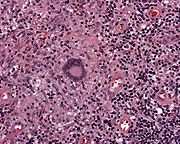
Langhans giant cell
Encyclopedia

Giant cell
A giant cell is a mass formed by the union of several distinct cells . It can arise in response to an infection or foreign body.Types include:* foreign-body giant cell* Langhans giant cell* Touton giant cells...
s (also known as Pirogov
Pirogov
Pirogov , or Pirogova is a Russian surname and may refer to:People*Alexander Pirogov , Russian Soviet opera singer*Grigory Pirogov , Russian Soviet opera singer...
-Langhans cells) are large cells found in granulomatous conditions.
They are formed by the fusion of epithelioid cell
Epithelioid cell
Epithelioid histiocytes are activated macrophages resembling epithelial cells: elongated, with finely granular, pale eosinophilic cytoplasm and central, ovoid nucleus, which is less dense than that of a lymphocyte...
s (macrophage
Macrophage
Macrophages are cells produced by the differentiation of monocytes in tissues. Human macrophages are about in diameter. Monocytes and macrophages are phagocytes. Macrophages function in both non-specific defense as well as help initiate specific defense mechanisms of vertebrate animals...
s), and contain nuclei
Cell nucleus
In cell biology, the nucleus is a membrane-enclosed organelle found in eukaryotic cells. It contains most of the cell's genetic material, organized as multiple long linear DNA molecules in complex with a large variety of proteins, such as histones, to form chromosomes. The genes within these...
arranged in a horseshoe-shaped pattern in the cell periphery.
Although traditionally their presence was associated with tuberculosis
Tuberculosis
Tuberculosis, MTB, or TB is a common, and in many cases lethal, infectious disease caused by various strains of mycobacteria, usually Mycobacterium tuberculosis. Tuberculosis usually attacks the lungs but can also affect other parts of the body...
, they are not specific for tuberculosis or even for mycobacterial disease. In fact, they are found in nearly every form of granulomatous disease, regardless of etiology.
Terminology
Langhans giant cells are named after Theodor LanghansTheodor Langhans
Theodor Langhans was a German pathologist who was a native of Usingen, Duchy of Nassau. He studied medicine at the University of Heidelberg, and at the University of Göttingen under Friedrich Gustav Jakob Henle , at Berlin under Rudolf Virchow and in Würzburg, where he became an assistant to...
(1839–1915), a German pathologist.
They should not be confused with Langerhans cell
Langerhans cell
Langerhans cells are dendritic cells of the skin and mucosa, and contain large granules called Birbeck granules. They are present in all layers of the epidermis, but are most prominant in the stratum spinosum. They also occur in the papillary dermis, particularly around blood vessels, as well as...
s, which are mononuclear epidermal dendritic cells derived (like Langhans cells) from monocytes and named after Paul Langerhans
Paul Langerhans
Paul Langerhans was a German pathologist, physiologist and biologist.-Eponymous terms:* Islets of Langerhans - Pancreatic cells which produce insulin...
. (The Islets of Langerhans
Islets of Langerhans
The islets of Langerhans are the regions of the pancreas that contain its endocrine cells. Discovered in 1869 by German pathological anatomist Paul Langerhans at the age of 22, the islets of Langerhans constitute approximately 1 to 2% of the mass of the pancreas...
are also named after Paul Langerhans.)

